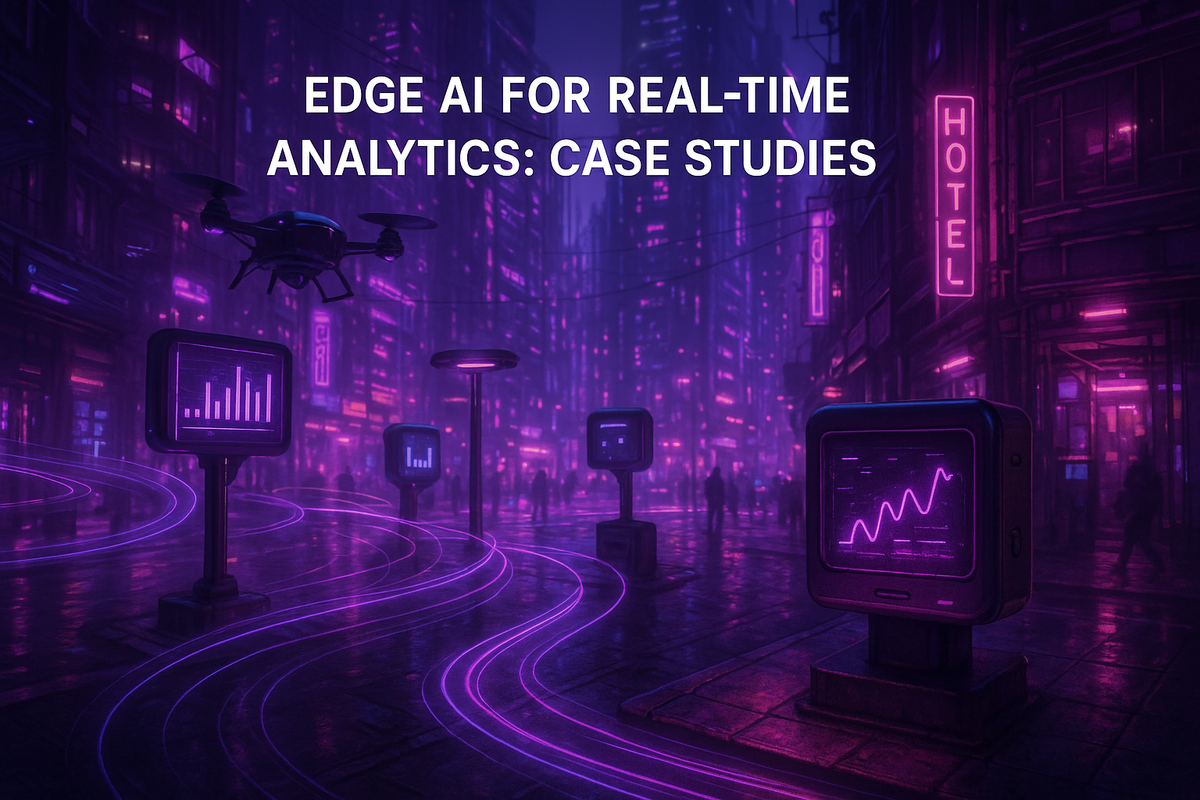Edge AI for Real-Time Analytics: Case Studies
Explore how Edge AI is transforming industries by enabling real-time data processing, enhancing privacy, and improving decision-making.

Edge AI is reshaping how data is processed by enabling local, real-time decision-making. Unlike traditional cloud systems, Edge AI processes data directly where it is generated - on devices like sensors, vehicles, or medical tools. This reduces latency, enhances privacy, and ensures reliable operations even with poor connectivity.
Key points:
- Faster decisions: Processes data in milliseconds for instant insights.
- Improved privacy: Keeps sensitive data on-site, reducing transmission risks.
- Reliable performance: Operates smoothly even without stable internet.
Technologies driving Edge AI:
- Lightweight neural networks: Optimized for small devices.
- Federated learning: Trains models locally, safeguarding data.
- Edge-cloud orchestration: Balances tasks between local devices and the cloud.
Applications:
- Manufacturing: Detects equipment issues and improves quality control.
- Autonomous vehicles: Enables real-time navigation and safety decisions.
- Healthcare: Provides instant patient monitoring and diagnostics.
While Edge AI offers clear benefits, integrating it with older systems can be challenging. Expert guidance is often needed to ensure smooth deployment and compliance with strict U.S. regulations. Businesses adopting Edge AI are seeing faster operations, cost savings, and safer data handling.
Part 7. | Case Studies & Real-World Results - Yield Gains & Production Uplift
Key Technologies Behind Edge AI
Edge computing hinges on three main technologies - lightweight neural networks, federated learning, and edge-cloud orchestration - to deliver real-time insights while ensuring high performance and robust security.
Lightweight neural networks make on-device processing efficient and feasible. Traditional deep learning models often require hefty computational power, making them impractical for smaller devices like sensors or cameras. To address this, techniques such as model pruning, quantization, and knowledge distillation are used to shrink model sizes and reduce resource demands. A great example is MobileNet, which performs image recognition using significantly fewer resources compared to standard convolutional networks.
Federated learning is reshaping how Edge AI systems learn and adapt. Instead of transferring raw data to a central server for training, this approach allows models to be trained directly on edge devices. Each device processes its local data and shares only the learned parameters - not the raw data itself - with a central system. This method is particularly valuable for organizations in the U.S. that must comply with privacy regulations like HIPAA or financial data laws. By keeping data local and sharing only encrypted updates, federated learning ensures privacy while enabling faster response times. This is especially critical for applications like patient monitoring or autonomous decision-making, where latency and data security are paramount.
Edge-cloud orchestration optimizes the balance between local and cloud-based processing. Some tasks require the scalability of cloud resources, while others demand immediate, local execution. Orchestration systems allocate tasks based on factors like latency, data sensitivity, and the computational capacity of devices. These systems also handle model updates and ensure compatibility across devices, creating a seamless interplay between edge and cloud environments.
Security and compliance are deeply embedded in these technologies. Edge AI must meet strict U.S. privacy standards, particularly in regulated sectors like healthcare and finance. Built-in safeguards - such as trusted execution environments and multi-level encryption (including emerging homomorphic encryption methods) - protect both data and computations, ensuring compliance with stringent U.S. regulations.
These technologies collectively enable Edge AI to deliver real-time data processing while maintaining the performance and security standards demanded by U.S. enterprises. As hardware evolves and software techniques advance, the capabilities of edge-based analytics continue to grow, paving the way for the diverse applications discussed in the next section.
Case Studies: Edge AI Applications Across Industries
Edge AI is reshaping industries by enabling faster decisions, cutting costs, and improving efficiency through localized data processing. These case studies dive into real-world applications, showing how different sectors are leveraging this technology.
Smart Manufacturing: Predictive Maintenance and Quality Control
Manufacturers are turning to Edge AI for real-time monitoring and on-site data analysis. Predictive maintenance powered by edge devices can spot anomalies before they lead to equipment failures, saving both time and money. Instead of sending massive amounts of sensor data to the cloud, processing it locally allows for immediate action.
On production lines, computer vision models running on edge devices inspect products at high speeds, catching flaws that human inspectors might miss. When defects are identified, the system notifies operators and can even tweak production settings in real time to prevent further issues. This continuous optimization not only improves product quality but also cuts down on energy use and material waste.
| Aspect | Benefits | Challenges |
|---|---|---|
| Response Time | Instant alerts for quick action | Requires robust hardware and seamless integration |
| Cost Efficiency | Cuts downtime and reduces data transfer costs | High initial investment in new equipment |
| Data Security | Keeps sensitive production data local | Complexities in integrating with older systems |
| Scalability | Flexible for various production lines | Demands specialized expertise for long-term support |
Autonomous Vehicles: Real-Time Decision-Making
Autonomous vehicles depend on Edge AI for split-second decisions. By processing data from cameras, lidar, radar, and GPS directly within the vehicle, tasks like emergency braking, obstacle avoidance, and path planning are handled without delay - critical for safety. Unlike cloud-based systems, edge processing ensures these vital functions work even if connectivity is interrupted.
Edge AI also powers smart traffic systems and vehicle-to-everything (V2X) communication, allowing vehicles to interact with traffic signals and other infrastructure in real time, further enhancing safety and efficiency.
| Metric | Edge AI | Cloud-Based Systems |
|---|---|---|
| Response Latency | Extremely fast for instant decisions | Slower due to transmission delays |
| Bandwidth Usage | Low, as data is processed locally | High, requiring constant data streaming |
| Privacy Protection | High, since data stays within the vehicle | Lower, as data is sent externally |
| Connectivity | Works well even with spotty internet | Relies on stable and continuous connections |
Healthcare: Patient Monitoring and Diagnostics
Edge AI is revolutionizing healthcare by enabling real-time monitoring and diagnostics. Devices like wearables and bedside monitors can analyze patient vitals on the spot, providing early warnings for potential health issues. This localized processing ensures faster responses, which is particularly critical in emergencies.
Diagnostic tools enhanced with edge capabilities can offer preliminary results at the point of care. This is especially valuable in remote areas or during urgent medical situations, where quick decisions can make all the difference. By keeping sensitive patient data local, these systems also help maintain compliance with regulations like HIPAA while improving patient privacy.
| Application Area | Key Benefits | Adoption Considerations |
|---|---|---|
| Emergency Response | Enables rapid alerts and diagnostics | Needs smooth integration with existing systems |
| Chronic Disease Management | Supports continuous monitoring and early action | Requires investment in training and technology |
| Rural Healthcare | Provides immediate diagnostic capabilities | Limited technical support in remote areas |
| Data Privacy | Protects patient information with local processing | Must meet strict compliance standards regularly |
| Cost Efficiency | Reduces hospital readmissions through proactive care | High upfront costs for advanced equipment |
These examples highlight how Edge AI is transforming industries by bringing intelligence directly to where data is generated. Faster processing, improved security, and reduced reliance on cloud systems are just some of the advantages. For businesses ready to explore these opportunities, NAITIVE AI Consulting Agency offers guidance on implementing these cutting-edge solutions.
Challenges and Solutions in Edge AI Deployment
Deploying Edge AI solutions, while promising, comes with its fair share of challenges - especially when it comes to integrating with older, legacy systems. Many organizations still depend on outdated infrastructure that wasn’t designed to handle the demands of modern AI. These systems often lack essential features like modern APIs or standardized data formats, making it tough to achieve seamless communication with new AI technologies.
To address this, it’s crucial to conduct a detailed analysis of your current operations. This helps identify the best strategies for merging legacy systems with AI applications. A well-thought-out integration plan ensures that AI technologies are not only implemented effectively but also meet security and regulatory requirements. However, bridging the gap between old and new systems often requires niche expertise.
That’s where engaging specialists, such as NAITIVE AI Consulting Agency, can make a difference. Their expertise helps guide organizations from the proof-of-concept stage to full-scale deployment, embedding AI into existing workflows with minimal disruption to daily operations.
Edge AI Impact on US Enterprises
Edge AI is revolutionizing how U.S. businesses operate by enabling real-time analytics that enhance decision-making. Companies integrating these technologies are seeing gains in efficiency, cost control, and customer satisfaction.
In manufacturing, the results are clear. With Edge AI-powered predictive maintenance, potential equipment issues are flagged early, allowing for timely repairs. This minimizes downtime and ensures production quality remains steady.
Healthcare providers are also reaping the rewards. Real-time patient monitoring systems powered by Edge AI can detect sudden changes in a patient’s condition, enabling immediate medical interventions when they’re most needed.
In transportation and logistics, Edge AI is helping businesses streamline operations. By analyzing local data - such as traffic, weather, and delivery schedules - fleet management systems can optimize routes, reduce fuel use, and enhance safety measures, all without relying on cloud connectivity. This means faster, smarter decisions on the go.
These examples highlight the powerful impact of Edge AI across various industries. To fully harness its potential, organizations need a solid strategy and expert support. NAITIVE AI Consulting Agency specializes in creating AI solutions that process data efficiently at the edge while driving impactful business results.
With competition heating up, delaying Edge AI adoption could leave businesses struggling to keep up.
FAQs
How does Edge AI protect sensitive data in highly regulated industries like healthcare and finance?
Edge AI boosts data privacy and security by handling information directly on devices instead of relying on centralized servers. This local processing reduces the risk of exposing sensitive data to cyber threats and keeps critical information closer to its source.
In sectors like healthcare and finance, where strict regulations such as HIPAA, GDPR, and CCPA apply, Edge AI supports compliance through secure encryption, strong access controls, and privacy-focused approaches like federated learning. These techniques protect sensitive data while still allowing for real-time analytics and actionable insights. By emphasizing transparency and user control, Edge AI creates a secure environment for managing regulated data with confidence.
What challenges do businesses face when integrating Edge AI with legacy systems, and how can they address them?
Integrating Edge AI with older systems often comes with its fair share of hurdles. Common obstacles include data incompatibility, outdated infrastructure, and limited computational resources. These factors can disrupt smooth communication between systems, making it harder to tap into the full potential of AI.
To address these challenges, businesses can turn to solutions like middleware and APIs, which act as bridges between legacy systems and modern AI technologies. Another key step is performing data cleansing and reformatting to ensure the data aligns with AI requirements. A phased integration strategy can also be highly effective, allowing organizations to roll out changes gradually. This approach helps minimize disruption, maintain day-to-day operations, and reduce risks. With a well-thought-out plan, companies can update their systems and unlock the benefits of AI without unnecessary downtime.
What makes Edge AI faster and more reliable than traditional cloud-based AI for real-time analytics?
Edge AI sets itself apart from the traditional cloud-based approach by handling data processing directly on devices rather than relying on remote servers. This on-device processing eliminates the lag caused by sending data back and forth over the internet, making it ideal for real-time decision-making. This capability is especially important for applications like autonomous vehicles or industrial automation, where even a slight delay can have serious consequences.
Another advantage of Edge AI is its reduced reliance on a steady internet connection. This makes it a dependable solution in areas with weak or inconsistent connectivity. By processing data closer to its source, it also adds an extra layer of privacy and security, as sensitive information doesn’t need to be transmitted across networks. On the other hand, cloud-based AI often demands high-bandwidth connections and can suffer from delays, making it less practical for scenarios that require immediate responses.




